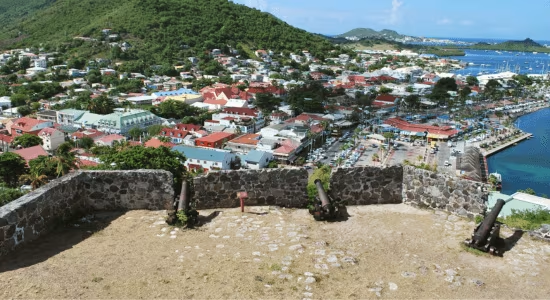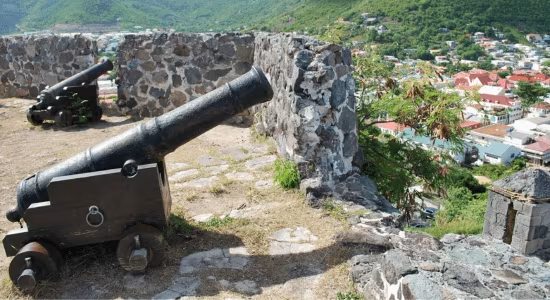Heritage Sites and Museums in Saint Martin and Sint Maarten
In 1781, Sint Maarten was occupied by the British. In 1794, the Dutch occupied the Island, then the French in 1796. To end up with a new British occupation that happened in 1810. Then the British conceded back their part of the island to France. The Franco-Dutch agreement of 1839, which specifies the modalities of cohabitation between the two parts of the territory, is still in force.
At the end of the 19th century, Sint Maarten opened its saltworks to allow industrial exploitation of saltworks production, thanks to a steam boiler. Only vestiges of this period remain today. Visiting these historical places is one of the biggest attractions of Saint Martin, especially if you love history.
95% of the economic resources of both territories of St. Martin's island is based on tourism. In addition to its natural riches, several historical sites and museums are unmissable in Sint Maarten.
Let's go! Embark onboard your rental car to find out more about Saint-Martin!
1- Fortifications of St. Martin's island
Both parts of the island have fortifications that reflect the history of the island. On the French side of the island, capital Marigot is protected by Fort Saint Louis. While Fort Amsterdam watches on the Dutch side and over tranquillity of Philipsburg.
A. Saint Louis Fort in Marigot - on the French side of the Island
Dating from the 18th century, Saint Louis Fort was built to protect the French side of Saint Martin. As the port warehouse stored the island's crops, the Fort served to protect them from adverse attacks. This place was the seat of many battles between the French and British. They disembarked from Anguilla to obtain supplies at a low cost. The Fort was first restored in the 19th century and then it has been abandoned. With the development of tourism, Saint Louis Fort has been renovated to welcome visitors in 1993. To discover Saint Louis Fort, you can park at the former location of the sub-prefecture, which has been heavily damaged by Hurricane Irma. The former sub-prefecture is now completely destroyed. From this place, you can then climb a few steps to reach the Fort and enjoy the gorgeous and panoramic view of Marigot and the lagoon, with also Anguilla, Baie Nettlé, Simpson Bay, and the Lowlands.

© Credit source : Canva
B. The Amsterdam Fort in Philipsburg - on the Dutch side of the island
The Amsterdam Fort is located in the heights of Philipsburg in Sint Maarten. Dutch settlers built the Amsterdam Fort in 1631. Two years later, the Spaniards grabbed the Fort to watch over the shipping route to Great Bay. They enlarged and fortified the Fort. When the Spaniards left St. Martin's island in 1648, the fort was destroyed. Nevertheless, vestiges of the Amsterdam Fort well worth the detour! Bird and nature lovers will discover a preserved site with brown pelicans and atypical vegetation.

© Credit source : Canva
2- Sint Maarten museum in Philipsburg
This free entrance museum, located at 7 Front Street in Philipsburg, is open every weekday from 10 am to 4 pm. You can find there the cultural heritage of Sint Maarten. The museum shows the island's eventful history, from the pottery shards of the Arawak Indians' craftsmanship, who were native residents of the island, to the result of the devastating Hurricane Luis in 1995. You can also find artifacts from the plantation era and items collected from the frigate HMS Proselyte, which sank off the Amsterdam Fort in 1801.
3- Amuseum Naturalis in Quartier d’Orléans
This free entrance museum is located in Quartier d'Orléans in Saint-Martin, on the French side of the island. It is open from Tuesday to Saturday from 9 am to noon. This museum reveals the nature of the island through a beautiful botanical walk. The Amuseum Naturalis also illustrates the heritage of St. Martin's through traditional building techniques that provide a very special charm to local houses.
4- Vestiges of the sugar industry
In St. Martin's island, sugar production dates from the middle of the 18th century. Even if this industry has been given up, some interesting vestiges of this era remain, notably the Spring sugar factory. Guadeloupean merchants launched the sugar industry in the south-west of the town of Marigot. During a century, sugar industries produced sugar and rum in large numbers. Today you can visit the large chimney built-in cylindrical limestone, the animal mill, the purging place to bleach sugar, and the alembic oven.
Between its natural resources, its vibrant cultural life, its shops where you can make great deals, its restaurants with succulent food, and also its bars or nightclubs, St. Martin's island has a "Friendly Island" image. Make sure you have booked a car at a car rental company before coming. That way, as soon as your plane lands, you can continue your journey with complete freedom of movement. Be careful about your valuable items, never leave them in the car or they might be stolen.

Subscribe to our newsletter and receive our best offers of the moment exclusively
CAR RENTAL CATEGORIES
CAR RENTAL LOCATIONS
BEST OF ST MAARTEN


Trip advisor

World Award

Kayak Award
©Europcar St Maarten : Car Rentals
